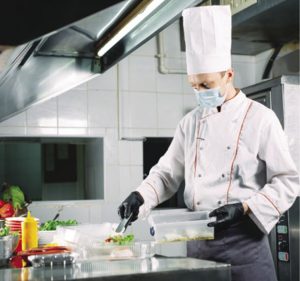With a move towards more hybrid working modes at least in the short term, how can catering facilities deal with unpredictable customer volumes?
Prentice: “This is our biggest long-term challenge. The answer really depends on who you talk to. We know that people are not going down the 100 per cent home working route but degrees will vary. We need to be prepared for any eventuality and we know that customer service is going to be more important now than ever before.
There are some certainties. Whatever model is deployed, people will want the food they couldn’t have at home, and hospitality in workplaces is going to be less about corporate entertaining, and more about team collaboration.
We feel there will be a greater demand for take home kits, if people are working from home the following day. The key requirement for us is flexibility. People are used to living differently so we will have to adapt.
I believe it will differ from sector to sector, and geography will matter too. For example, the City is going to be the biggest challenge and regions will be less impacted. Blue collar working won’t change much as home working is much less of an option. As things reopen, there will be patterns developing and we will need to continue to be agile and adapt. Caterers are very used to this.”
Mahoney: “Even pre-COVID, we would work closely with clients to determine volumes, external visitors and behaviours on a very regular basis. It is in the interests of both the caterer and the client to ensure that we are monitoring building footfall and staying abreast of activity within the organisation to understand what type of service will be required. This collaboration is going to be vital moving forward.”
 Hurst: “Being agile and dealing with ever changing fluctuations in demand is no different in catering than in a restaurant or pub where demand has always ebbed and flowed with changes in the weather and all sorts of other external factors.
Hurst: “Being agile and dealing with ever changing fluctuations in demand is no different in catering than in a restaurant or pub where demand has always ebbed and flowed with changes in the weather and all sorts of other external factors.
By ensuring our menus are engineered to allow production to be quickly flexed and our staff trained and empowered to make decisions to deliver on this, along with constantly compiling and analysing occupancy and sales data, we minimise wastage.”
Will new technology such as pre-ordering via apps play a big part in streamlining catering services?
Prentice: “This is a massive part of all reopening plans. The pandemic has actually sped up the adoption rates of different tech. I’ve been trying to get clients to adopt some apps for years, the process was slow but it has sped up massively since the pandemic.
There are a lot of other elements to consider too. For example, smart vending is becoming more popular, frictionless fridges are increasing, cash is dying fast, pre-pay is on the rise. All of these developments will help to manage staffing levels and movement of people too.”
Mahoney: “Technology will play a broader role than just streamlining services, it will be an essential part of the transaction between customer and caterer.
Pre-COVID, uptake of technology may have been slower, but it has since ramped up as all parties understand the importance of the role it needs to play. Click and collect, pre-order, hospitality, meeting catering etc are all going to require technology to funnel and channel activity.”
Hurst: “Yes. There’s no doubt that COVID has accelerated the digitalisation of our lives and our operation has certainly benefitted from a sudden uplift in our customer embracing the tech we’ve spent the last few years putting in place.
We’ve obviously been in the delivered-in space since our inception so we have a good understanding of how tech can enhance our clients’ operations.
As an agile boutique caterer, we’ve always put tech at the forefront of how we run our operation. Working in partnership with some of the leading FoodTech companies in the world, we’ve implemented some incredible new features and services for our customer and operation to benefit from over the past 12 months.”
How have client demands altered since the pandemic and how are you responding to their requests?
Prentice: “Initially, safety was a massive concern. Now we know more about what is going on, the demands are largely geared around how we can use space better as people come back.
A big part our focus from clients is about how we can all work together to help attract people back to the office. We are working with clients on ways to entice people by using food as part of the draw.
Also, we are getting involved in more conversations about how we can facilitate collaboration. Meeting spaces and accessible open spaces are now being considered for catering and hospitality – all with the view to encouraging collaboration.
Most clients believe there will be a journey to a level of normality but accept that occupancy and movements won’t be as they once were.”
Mahoney: “The pandemic clearly came as a shock to all of us, however, if there is one silver lining to take from it, it’s the fact that there has been more of a sense of togetherness and collaboration across the industry.
We are working much more closely now with clients than ever before as we collaborate to ensure that we are supporting the needs of their employees.”
Hurst: “In terms of food service, clients have typically wanted to maintain the same quality and variety as pre-COVID but with everything serviced in a COVID-secure manner.
Having run a delivery catering operation alongside our delivered-in contract catering operation for many years now, we were able to seamlessly transition our contract clients over to our individually packed and labelled delivery products.
By combining this with our existing and enhanced online ordering systems, our clients were able to very quickly adapt a new way of providing great quality food and service to their employees.”




